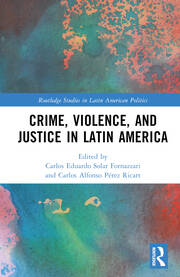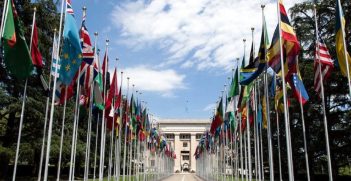Book Review: Crime, Violence, and Justice in Latin America

Violence and crime contribute to one of Latin America’s most pressing social problems. This book provides an overview of this issue, while establishing the broader contexts of how it came to be.
This is a good book. Although one has to wait until the last chapter to discover that the contributors of the book began writing their chapters following a conference in Oxford, UK, in the summer of 2019, the book greatly succeeds in providing the reader with a present-day mix of case studies directed at informing the reader of “why crime and violence persist in Latin America… and why the states have not been able to more effectively solve this problem that dominates the lives of many millions of Latin Americans.”
This book consists of 13 chapters including the introduction and the final remarks, divided into four major parts: Logics of Crime; Geographies of Violence: Urban and Rural Scenarios; Circulation of Policy Knowledge; and Criminal Justice and Homicide Investigation. Compared to the rest of the book, I found chapter one, the introduction to the book, a bit lacking. Perhaps because the use of terms such as “old and new forms,” “paradigms,” and “paradoxes,” among others. The chapter reminded me of my 2020 Annual Review of Sociology article titled, “Violence in Latin America: An Overview of Research and Issues,” which in retrospect, I must admit, I also find lacking. Leaving that chapter aside, I learned a great deal from the rest of the book.
The first part consists of two chapters, which together offer an exploration of the criminal underworld and governance in different national contexts. Chapter two, by Elena Butti, focuses on the behaviour of marginalised youths in Colombia. It challenges stereotypes and exposes their intricate relationships with law and morality. In chapter three, José Miguel Cruz investigates the roles of El Salvador gangs in political administration and order, highlighting their influence beyond just local communities to shape nationwide policies via coordinated violence. It emphasises how gangs interact transactionally with political groups as they exchange services for resources or privileges. In this way, these chapters provide a rich and detailed perspective on power dynamics amid governance and violence shaped by different societal contexts that highlight very intricate interrelationships between many variables.
The second part consists of three chapters, illustrating how violence and crime impact economically and politically across different Latin American cities and regions. This part begins with chapter four, by Veronica Azzi, which examines Rio de Janeiro’s military use of force to pacify criminal territories. In chapter five, Raul Zepeda Gil investigates organised crime dynamics in Mexico, where territorial control is contested amid agro-industry policies and military interventions. Chapter six, by Louis-Alexandre Berg, presents a rich description of political-criminal collaboration in Honduras, highlighting how criminal-state cooperation is a major threat to democracy for the entire Central America region.
The third part consists also of three chapters. These chapters deal with security, governance, and the role of different actors in the creation of security policies, which is welcomed as the section focuses on a rather understudied topic in Latin America. This part begins with chapter seven, by Markus Hochmüller, which focuses on the role of the private sector in security reform in Guatemala. Hochmüller argues that the elite and private sector law-and-order agenda has limited impact and suggests evaluating other models that address socio-economic conditions contributing to violence. In chapter eight, Jan Eijking looks at why Colombia exports its security expertise to other countries and warns the reader to think about whether there’s enough oversight of these exports. In chapter nine, Logan Puck debates Mexico’s private security industry’s militarised approach, characterised by their preferences for hiring ex-military personnel and how they use these hiring policies for marketing. Puck raises concerns over this trend which could lead towards more militarisation and suggests further research into the motivations and consequences of such hiring preferences.
The fourth and final part consists of four chapters. The first three are, as the title of this part promises, all about criminal justice and homicide investigations. However, each chapter provides different insights into the systems of different countries. In chapter ten, Mariana Gutiérrez and Gabriel Costantino describe how Argentina’s criminal prosecution system operates and highlight the discretionary powers that police investigators hold, particularly in the case of the Airport Security Police, and how they collaborate with judicial actors. In contrast, chapter 11, by Gabriel Feltrán, takes a closer look at crime and violence dynamics in Brazil by examining how criminal factions decreased homicides through internal justice mechanisms. Finally, in chapter 12, Daniela Collazos, Leopoldo Fergusson, Miguel Emilio La Rota, Daniel Mejía, and Daniel Ortega evaluate a new approach to homicide investigations in Bogotá, Colombia, that leads to a higher proportion of charges and convictions. Teamwork coordination is hypothesised to be the main factor to the success of this new approach. These chapters, taken as a whole, provide valuable information about different Latin American criminal justice systems, showing the richness of comparative research and of evaluation methods for enhancing criminal investigation and justice. Finally, chapter 13 is the editors’ wrap-up. It is titled “Final Remarks: Security in Latin America Post-COVID-19.” It consists of a summary of the works presented, framed in the context of the pandemic, and with the intent to provide an agenda for future studies. The editors emphasise the need to “reconsider the capacity of state-centric explanations,” and that “public security governance must be understood from the particularities observed because of the dialogue between micro and macro (the individual and society). It is in the micro-dynamics of criminality that the grooves of causal mechanisms are worn.”
In my view, the value of the book, like with any multi-contributor edited book, lies in the heterogeneity of the issues at hand and the variety of case studies. For the general reader, this book will provide a sample of works related to one of the most pressing social problems in Latin America, which is violence and crime. For the more specialised reader, it will provide rich contextual information on a wide variety of places in Latin America that are not commonly found in one edited book only. In this regard, while the focus of the book is diverse, and the number of contributors many, I do not find the quality of the contributions diverging. Yet, I would have liked the editors to have taken the opportunity to extend their final section with a heavier theoretical discussion and more discussion on the solutions being offered by the contributors. I say this because, for the reader, general or specialised, it will not be easy to draw all the information together into a few lines to remember. There is a lot of information, and theories can help with synthesising patterns of information. Now, to be fair, and coming back to the title of the book, one will know that any editorial attempt in this regard will be an incredibly difficult task. Therefore, I commend the editors and the contributors for their work. Because of my profession, I read academic books, however, not all are worth reading – much less reviewing. Reading and reviewing this book was certainly worthwhile.
This is a review of Carlos Solar and Carlos A. Pérez Ricart, Crime, Violence, and Justice in Latin America (Routledge, 2023). ISBN 9781032206844.
Carlos Vilalta is a Professor and Researcher at the Center for Research in Geospatial Information Sciences (CentroGeo-Conacyt), and a member of the National System of Researchers of Mexico. His research examines the geography of crime, fear of crime, social disorder, social conflict, and criminal statistics.
This review is published under a Creative Commons License and may be republished with attribution.





